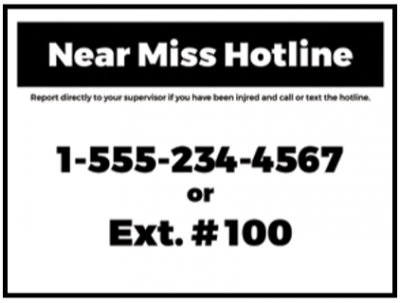You Can’t Miss with a Near Miss Hotline
You Can’t Miss with a Near Miss Hotline
“I created our near miss hotline to make safety more personal and more available to the employees in our production area,” says Drew Smith, safety director for Clearspan Components in Meridian, Mississippi (pictured top of next page). It also solved a very real problem for the company. Too often an incident would occur in the plant and Drew was either hearing about it long after the fact or, in a few cases, not hearing about it at all. Let’s explore what Drew did to ensure his team knows who and when to call when anything safety-related happens at Clearspan.
When the unthinkable happens, a catastrophic accident or injury, everyone is ready to radio it in, find a supervisor, or dial 911, but many manufacturing-related incidents are somewhat minor. As a consequence, they can often go unreported. The goal of a near miss hotline is to give everyone a fast and easy way to report what they are seeing every minute of every day, both big and small.
“Our facility is fairly expansive, so we use two-way radios to communicate,” Drew says, “but we needed a better solution for all of our employees since there wasn’t always a radio nearby.” Drew also found that if he was off the production floor in his office, people were reluctant to take the time to walk over to the safety trailer and find him. Based on this, the Clearspan Near Miss Hotline was born.

The premise is basic. First, identify a number that can be called any time, day or night, that gets you a direct line to Drew. Second, design some simple, easy-to-read signs (or download this template). Third, print dozens of copies. Finally, put them up EVERYWHERE.
There’s not a direction you can turn “in the production area at Clearspan, inside or out,ˮ where you can’t immediately find the number on a sign. “In this day and age, nearly everyone (or someone right next to them) has a cell phone in their pocket, so it made sense for me to tap into that for the occasions when there was an incident and someone needed immediate assistance.” In addition, as part of Clearspan’s new employee orientation class, each employee is asked to add the number to their cell phone as part of the onboarding process. While they are adding the number, Drew gives a few examples of the kinds of things they should use the number to report, whether it’s an accident, near miss, or similar incident.

“I think it’s helpful that they know their first day they have a direct line to me that is both immediate and confidential,” Drew explains. “It’s not uncommon for people to avoid reporting an incident for numerous reasons, but we can see that this is breaking down that barrier.”
Beyond improving employee morale, it also helps Drew handle incidents in real-time rather than at the end of a shift or worse, a few days later. Even the smallest cuts can lead to big problems if they are ignored.
The hotline has also provided another way to track incidents, since the Google Voice account they use creates traceable data that only Drew or management can review. The voicemail feature, in particular, has been instrumental in developing data log sheets for any calls Drew receives when he is in a meeting or out of the office.
Their near miss program has become a window into the production area too, helping Drew and the rest of their management team know exactly what is taking place at all times. This approach promises to have significant impacts on their overall injury rates, and therefore their bottom line. “Something this simple has declined our workforce injuries by at least 60 percent,” Drew says, “and we’re confident that will continue to rise in the future as we continue to establish rapport with our team.”
“In my experience, our near miss hotline cuts out the guesswork and has given me the opportunity to show the human side of safety,” Drew says. “It’s really become more than a near miss hotline. My team knows they can call this line with any safety question…and sometimes just an ear to listen. And for me, thatʼs what safety is about. It’s bigger than incidents and injuries. It’s about making yourself available to others in many capacities.”
Why Tracking Near Misses Is So Important
From the December 2016 SBC Magazine article “Why Track Leading Indicators?”
…traditional safety metrics are reactive, bottom-line numbers that can only provide after-the-fact information. They are past accident statistics that are not focused on prevention.
California TrusFrame (CTF)…focuses on leading indicators like “employee training, safety assessments and audits, and a near-miss reporting program.” Performance-focused benchmarks allow [CTF]’s safety team to “track improvement and force proactive behavior” instead of fixating on failure-based information. A near-miss reporting program helps the CTF team be “predictive and track impact versus intention.”
Implementing a near-miss program is an easy first step toward a proactive safety culture. All you need is a form to collect the location, date, time, and description of the incident.

